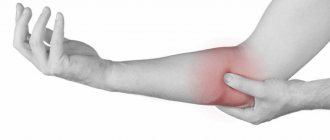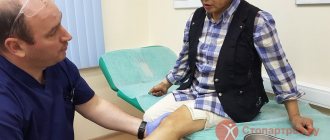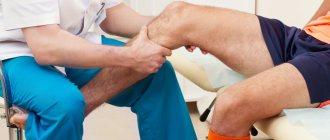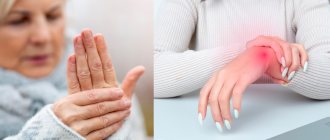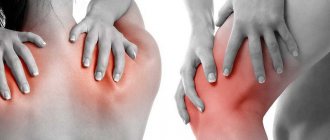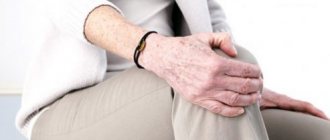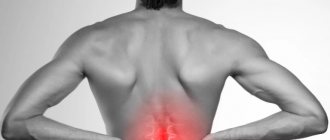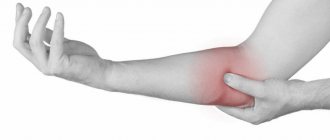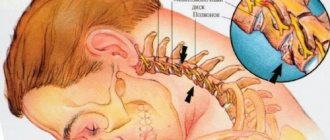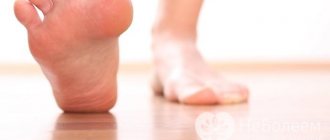Causes of crunching in joints in different age groups of patients
It is generally accepted that crunching in the joints when bending indicates some kind of malfunction in the musculoskeletal system. In fact, this is not always the case. Crunching in joints without pain is common in adolescence. The reason is rapid spasmodic development and temporary anatomical imbalances. The causes of pain and crunching in joints in patients over 60 years of age are most often inflammatory or degenerative diseases. In these cases, examination and adequate therapy are necessary.
Bursitis
Bursitis is an acute or chronic inflammatory disease, accompanied by an increase in the volume of the synovial bursa due to the accumulation of exudate in it. In 85% of diagnosed cases, the pathology was detected in men. The development of bursitis is caused by injury or rheumatoid diseases. In men, the cause of degenerative joint changes is excessive physical activity, especially heavy lifting. Most often, joints crack due to bursitis in the knees and elbows as a result of damage to the prepatellar bursae.
Sometimes the mechanism for the formation of these sounds is based on an inflammatory process provoked by the penetration of pathogenic microorganisms into the tissue. Infectious agents quickly form primary or secondary foci of pathology, releasing toxic products of their vital activity. In addition to crunching, patients at doctor’s appointments complain of the following symptoms:
- pain, the intensity of which increases with increased physical activity;
- swelling, swelling in the joint area, stiffness of movement.
Crunching and clicking often become one of the main clinical manifestations of Baker's cyst. With this pathology, a large volume of fluid accumulates in the synovial bursa, sometimes leaking into the surrounding tissues.
Bursitis is diagnosed in every 200 patients who come to a hospital with complaints of pain and clicking during movement.
Crunch in the shoulder joint
In medicine, the characteristic crunching sound is called crepitus. It appears when two hard surfaces come into contact, for example, with osteoarthritis, when the elastic cartilage tissue covering the joint is destroyed. What causes the specific sound? When moving, the volume of the joint capsule increases, as a result of which the pressure drops and bubbles of carbon dioxide form in the intra-articular fluid. When they burst, a characteristic click is heard.
Shoulder clicking in people under 35 years of age may be the result of an injury to the shoulder muscles. In this case, rest and physiotherapeutic procedures will help. Usually after 2-4 months the crunching disappears. In patients aged 35 to 60 years, crepitus combined with pain may be signs of inflammation. This condition can be successfully treated in the early stages with physiotherapy sessions. In later stages, corticosteroid injections are prescribed to relieve inflammation.
Patients over 60 years of age usually experience pain along with a crunch in the shoulder joint. In such cases, you should consult a doctor to make a diagnosis and prescribe treatment. As a rule, the cause of pain and crunching is arthritis. Read more about the treatment of arthritis on our website Dobrobut.com.
Arthritis
Arthritis is acute or chronic damage to the joints, which can be an underlying disease or a consequence of another pathology. The basis of pathogenesis is any autoimmune disorder. Most often, the regulation of rheumatoid factor synthesis is disrupted, leading to synovitis or generalized vasculitis. Rheumatoid arthritis is characterized by the formation and proliferation of granulation tissue in the synovial membrane, destroying cartilage and bone structures. The following pathological conditions result from destructive-degenerative changes:
- erosion;
- sclerotic changes;
- fibrous and then bone ankylosis.
Why joints click during arthritis, doctors explain by closer contact of the inflamed articular surfaces with each other. Cartilaginous tissue loosens and loses its smoothness, which causes the formation of unevenness and roughness. Clicking also provokes an inflammatory process; the concentration of proteins in the synovial fluid increases, contributing to a change in its consistency and the formation of air bubbles, increasing the severity of cavitation.
Even at the initial stage of arthritis, a person feels pain, the intensity of which depends on the type of pathology. Often, severe swelling and redness of the skin occurs in the area of inflamed joints that lose mobility. In the absence of medical intervention, the patient gradually loses his ability to work and cannot perform basic movements, for example, holding a spoon.
American doctor Donald Unger received the Ig Nobel (namely Ig Nobel!) Prize in 2009, having made a discovery in the medical field. The doctor regularly cracked the joints on his left hand for 60 years. After comparing the condition of the joints on both hands, it was experimentally proven that clicking does not cause the development of arthritis.
Crunching and pain in the joints: causes
The main causes of crunching in the joints:
- Heredity. Firstly, the consequence of more viscous collagen and increased ligament extensibility is a weak ligamentous apparatus. Secondly, a genetically determined decrease in the secreting function of the periarticular bursa and a lack of synovial fluid impairs gliding. Because of these reasons, crunching in the joints appears.
- Age. Crunching and pain in the joints in older people are associated with degenerative changes (wear and tear) of the joint.
- Functional disorders, injuries. Increased physical activity (among athletes, people engaged in heavy physical labor) can lead to arthrosis.
- Prolonged immobilization. Immobility is the same enemy of joints as increased stress. For example, after a broken leg, a patient may experience a crunch in the knee joint.
If crepitus is accompanied by pain, this is a sign of inflammatory or degenerative changes in the joint. A doctor must make a diagnosis and prescribe treatment for cracking joints. Self-use of medications and dietary supplements can only worsen the condition. For pain relief and inflammation, doctors usually prescribe NSAIDs (diclofenac, meloxicam). To nourish and restore cartilage tissue - chondroprotectors (glucosamine, chondroitin). It is important to monitor your weight. Every kilogram of excess weight adds six kilograms of stress to the joints of the lower extremities. Therefore, when a crunch appears in the hip joint, it is advisable to lose excess weight. Diet, gymnastics, walking, swimming, cycling will help with this.
Gonarthrosis
Diagnosing gonarthrosis often helps answer the question of why joints click. It refers to pathologies of the knee joints, which are characterized by gradual wear of cartilage and deformation of the joint due to disruption of the supply of nutrients to the tissue. The disease is often diagnosed in elderly and senile patients. Women are especially susceptible to it during natural menopause, which occurs against the background of hormonal changes and decreased calcium absorption. If adequate therapy is carried out in the later stages of gonarthrosis, it will not prevent the patient from becoming disabled. The impetus for the development of the disease is a decrease in the regenerative activity of tissue with constant mechanical pressure on the joint.
V.N. Levenets and V.V. Plyatsko examined biopsy material from the epiphysis of the femur and tibia, taken from 84 patients with gonarthrosis. It was found that microcirculation disorders are characterized by dilatation of blood vessels and the formation of blood clots in them. This provoked a deterioration in the trophic transport mechanism and activation of lysosomal enzymes.
The leading symptom in the clinical picture of gonarthrosis is always a dull pain in the knee joint, which intensifies when walking and any other type of movement. Its features:
- a significant increase in intensity during sudden temperature changes;
- a close relationship between severity and meteorological conditions, for example, high humidity.
As the pathology progresses, the pain syndrome begins to be accompanied by clicking and crunching sounds resulting from friction of the damaged joint surfaces. Gradually, the hypertrophied villi of the synovial membrane are pinched, which limits the range of movements. In severe cases of the disease, contracture develops, that is, the person loses the ability to fully bend and straighten the leg at the knee.
How to get rid of the problem?
If you are looking for a way to stop clicking your joints, you first need to understand what exactly causes this problem. For this purpose, you will need to contact a specialist who will prescribe certain diagnostics - x-rays, ultrasound, urine and blood tests, etc. The resulting tests will allow you to specify the cause, and therefore choose the right course of treatment.
If the problem is not pathological, then help will not have a specific direction.
But in case of serious illnesses, in order for the joints to stop clicking, you will need to take more impressive measures:
- Medications. Medicines containing glucosamine and chondroitin (for example, Glucosamine Maximum) are prescribed. These substances prevent the destruction of cartilage and bone tissue of the joint, thereby preventing the development of diseases, joints and ligaments. Chondoprotectors are also prescribed, which help restore damaged cartilage tissue. But the effect appears only after long-term use. This category of drugs may come in the form of tablets or injections. IMPORTANT! Whatever the instructions for the drug say, you need to understand that each organism is individual, and what suits one may only cause harm to another. Therefore, the dose and duration of administration should be calculated only by the attending physician.
- Injections. If the snapping joint has problems with natural lubrication, the patient may be prescribed hyaluronic acid to be injected directly into the joint. This restores mobility to the joint.
- Exercises. As surprising as it may sound, there is a group of specific activities that can eliminate unpleasant sound. For example, when a joint in the jaw clicks, you need to move forward (extend 3 cm), from side to side (all the way). But here you need to be very careful, since this approach is mainly used after injury. And not at every stage of healing you can give such a load. Therefore, the intensity in each individual case is selected individually.
- Sport. If there are such unpleasant sounds, then swimming can help get rid of them. This type of load allows you to maintain the tone of muscles and ligaments, but at the same time, at the same time, relaxes tension in the joints. Moderate physical activity (for example, daily exercises and walking), as well as exercise therapy, will also help eliminate the crunching.
- Massage course. This allows you to relax the muscles and ligaments, which means the pressure on the joints is reduced. But here it is important to find a professional massage therapist, otherwise you can only worsen the situation.
There are also general methods that can help you get rid of the problem:
- wearing elastic bandages - especially after an injury or during exercise;
- if the ankle joint (as well as other joints of the limbs) clicks, then measures such as acupuncture, paraffin baths, magnetic therapy, electrophoresis, etc. give a good effect;
- the use of warm compresses - this method is only permissible with the permission of the attending physician (high temperature can aggravate the condition, for example, as with inflammation);
- taking baths with sea salt or medicinal herbs;
- taking vitamin complexes and dietary supplements.
Important! You need to understand that all of the above methods are in addition to the main treatment.
Formation of osteophytes
The formation of pathological growths on the surfaces of bone tissue sometimes becomes the answer to the question of why the knees or feet click. Marginal growth of bones occurs as a result of deforming loads or when calcium metabolism is disrupted. The pathological condition can accompany all stages of osteoporosis and even some endocrine disorders, such as diabetes. Features of the development of diseases occurring against the background of the formation of osteophytes:
- with initial and moderate severity of degenerative changes, osteophytes provoke malnutrition of articular tissues and their inflammation. In foci of pathology, elastic cartilage grows, which gradually increases in size and ossifies;
- in severe cases of the disease, when complete regeneration of damaged tissue becomes impossible, osteophytes limit movement in the joint, slowing down its further destruction.
The initial stage of the formation of bone growths is asymptomatic, but as their size increases, the likelihood of injury to cartilaginous tissue increases. When events develop in such a negative scenario, the joint clicks, becomes inflamed, and its range of motion decreases. The intensity of pain is directly dependent on the degree of tissue destruction.
According to the results of an ultrasound examination, in 18 patients with osteoporosis in the rheumatology department of the Republican Clinical Hospital, osteophytes were found in all patients examined. In 81.2% of cases, symmetrical osteophytes were identified, located at the bases of the patellas and condyles of the femur and tibia.
Prevention
To avoid the unpleasant situation of clicking joints, you just need to remember about prevention. It is easier to prevent the development of a disease than to treat it later. In addition, the price of modern effective drugs in most cases is not small.
There are a number of general recommendations:
- if the work involves sitting for a long time, then it is necessary to take breaks every 30-40 minutes - it is best to devote them to squats or going up and down the stairs (can be replaced by stretching, rotating joints, etc.);
- when ligament weakness is diagnosed, elastic bandages should be worn;
- control your diet, especially focusing on the consumption of calcium-containing foods, with gelatin and rich in vitamins;
- to avoid foot problems, it is important to choose the right shoes;
- it is important not to allow yourself to become overcooled or overheated;
- when the wrist joint clicks, it is important to reconsider your load on your hands, especially if the work involves typing text - you will need a special stand for the joint or, at least, you will need to hold your hands in the correct position;
- If you remember that the temporomandibular joint clicks even from the stress of speaking, then you simply need to give your speech apparatus a break - this applies to those who talk a lot on duty (teachers, professors, actors, announcers, etc.).
All these tips are simple to implement, but they are highly effective in prevention. You can learn more about what causes clicking at bone joints and how to get rid of the unpleasant sound in the video in this article.
Medical recommendations
A rheumatologist or traumatologist evaluates the patient's general health. If a person is overweight, the doctor recommends contacting an endocrinologist to rule out endocrine disorders. If you are overweight, a nutritionist may be involved in treatment to help the patient get rid of extra pounds - a common cause of joint damage, especially in the legs and spinal column. To eliminate unpleasant clicking sounds, it is not enough to just take pharmacological medications. Strict adherence to medical instructions helps to bring recovery significantly closer:
- exclusion of physical activity . A predisposition to thinning of cartilage tissue or already developed articular pathology is a signal to limit excessive physical activity and (or) heavy lifting. For crunching and clicking, long walks in the fresh air, yoga, swimming, physical therapy or gymnastics are recommended;
- use of bandages . To limit joint mobility, it is advisable to wear knee pads, bandages or corsets. The range of orthopedic devices is very wide. You can purchase it immediately or order a bandage of the required size at a pharmacy or medical equipment store;
- drinking regime . You should drink at least 2-2.5 liters of fluid daily. This can be pure still water, chamomile and green tea, rosehip infusion, fruit compotes, berry fruit drinks. Drinking plenty of fluids helps remove excess mineral salts, pathogenic microorganisms, toxic end and intermediate products of the inflammatory process from joint tissues;
- rejection of bad habits . Poisonous tobacco tars, nicotine, and ethyl alcohol have a negative effect on the condition of blood vessels and microcirculation in deteriorating joint tissues. If it is impossible to give up bad habits on your own, then you should consult a narcologist and use pharmaceutical drugs.
What else needs to be done if your joints are cracking - adjust your diet. It excludes fatty foods, foods rich in salt and spices, and drinks with diuretic properties: coffee, lemonade, strong black tea. The daily menu should contain foods with a high concentration of Omega-3: fatty sea fish, legumes, vegetable oils. Polyunsaturated fatty acids and fat-soluble vitamins accelerate metabolism, promoting rapid regeneration of affected joint tissues.
Basic therapy methods
What to do if the joints click is decided only by the attending physician. When choosing a therapy method, it takes into account many factors: the stage of the diagnosed disease, the degree of tissue damage, the age, weight and gender of the patient, and general health. The presence of concomitant pathologies is also important, regardless of whether they cause constant clicking when moving. For example, if the patient has a history of hepatitis, cirrhosis or renal failure, then taking glucocorticosteroids may be prohibited. And for ulcerative lesions of the gastrointestinal tract, anti-inflammatory non-steroidal drugs are not included in therapeutic regimens.
I theory
If you take an x-ray of the joint immediately after clicking, cavitation bubbles will be visible. Clicking the same joint again will not work: first, the joint capsule must shrink to its previous volume, which is accompanied by an increase in pressure and complete dissolution of all gases (this takes approximately several hours).
As for the consequences of such entertainment, cartilage, unlike metal, does not crumble and is capable of regeneration (this can stimulate the regeneration of the joint, its restoration).
And yet, there is evidence that this entertainment can lead to a decrease in the motor functions of the joints and weakening of the hand (most likely, here the author extrapolates data from the hand to the spine, where hypermobility and instability can develop in some spinal motion segments, and vice versa in others – blockade, that is, restriction of mobility in the spinal motion segments).
Spraining the ligaments is also not beneficial (a very controversial point, spraining the ligaments leads to an improvement in their elasticity, and the elasticity of the ligaments is one of the most important parameters of healthy ligaments and which indirectly indicates a person’s age).
If we try to carry out a certain experiment, then indeed, at first “gas bubbles” are very intensively formed from the liquid, and then they can also intensively dissolve in it. But in practice, this experience is not accompanied by an acoustic phenomenon, i.e. sound.
